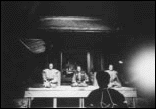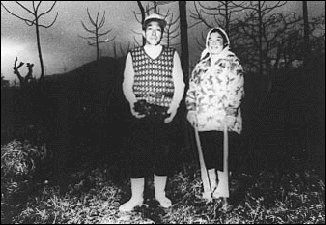―牧野村物語 |
|
|
|
製作:小川プロダクション Production Company : Ogawa |
| 牧野村に移って以降十数年、「牧野物語」として小川が撮り続けてきた集大成がこの大作である。そしてこの作品が特異なのは「堀切観音物語」と「五巴神社の由来」という牧野村にまつわる歴史を劇映画として再現している点にある。そして小川がこれまでの作品で獲得してきたあらゆる手法が解け合い、稲の生きる時間、人々の生きてきた時間、個人史、村の歴史、神々の時間、そして新たに劇映画として再現された時間など、複数の時間の帯が同時に示され一体化されることになった。牧野村の人々の顔は時には個人として、時には村の歴史の記憶を担う一人として、神話を語る語り部として、また劇映画の群衆の一人としていくつもの役割をこなし時間と空間を移動する。ついに小川の時間は牧野村の時間と一体化し、新たに発芽しはじめたことを明らかにした。しかし残念なことにこれは小川紳介の最後の長編となった。90年代において多くのドキュメンタリー作家が「私的」な方向へと回帰する現在、この作品がそれらの対極に存在する作品であることは重要な事実であろう。 | This important film compiles " Magino Story " footage taken by Ogawa for a period of more than ten years after he moved to Magino village. Unique to this film are fictional reenactments of the history of the village in the sections titled " The Tale of Horikiri Goddess " and " The Origins of Itsutsudomoe Shrine " . Ogawa combines all the techniques that were developed in his previous films to simultaneously express multiple layers of time--the temporality of rice growing and of human life, personal life histories, the history of the village, the time of the Gods, and new time created through theatrical reenactment--bringing them into a unified whole. The faces of the Magino villagers appear in numerous roles--sometimes as individuals, sometimes as people who carry the history of the village in their memories, sometimes as storytellers reciting myths, and even as members of the crowd in the fictional sequences--transcending time and space. In the end, Ogawa's time coincides with that of the village, and it becomes clear that a new form of time has been created. Sadly, this was Ogawa Shinsuke's last long work. Now, in the 1990s, when most documentary filmmakers have turned toward the " personal, " this film stands as an important example of the opposite pole of filmmaking. |

